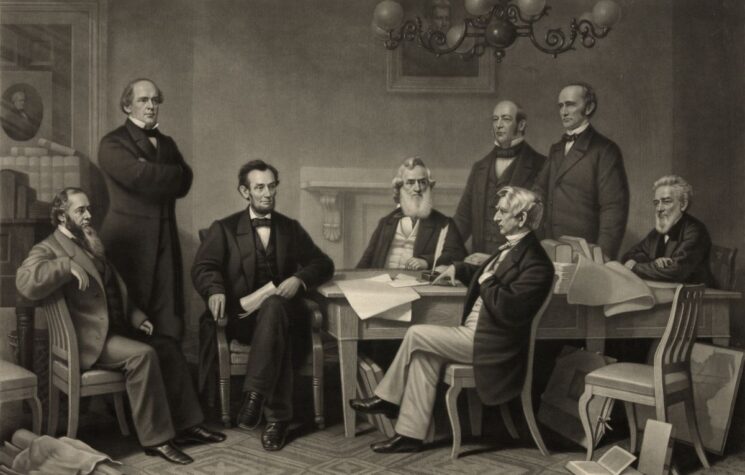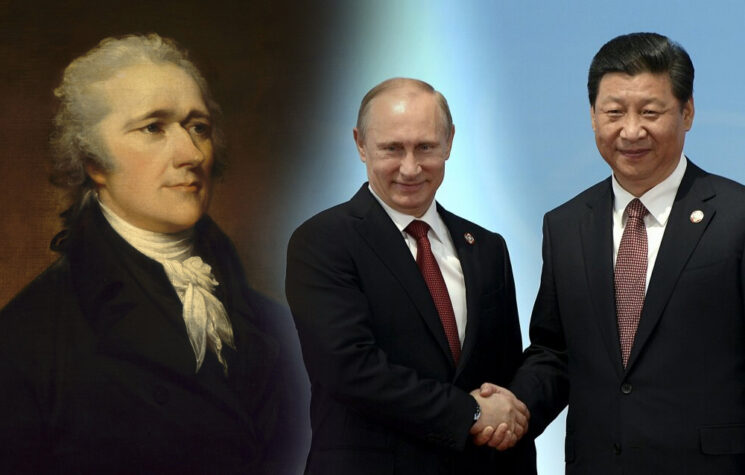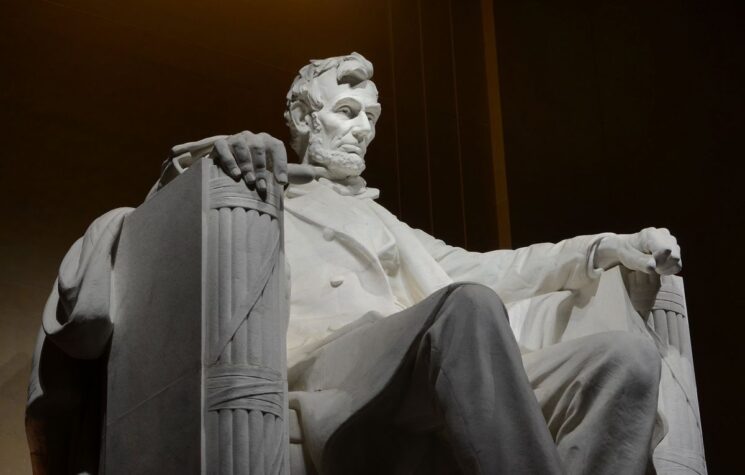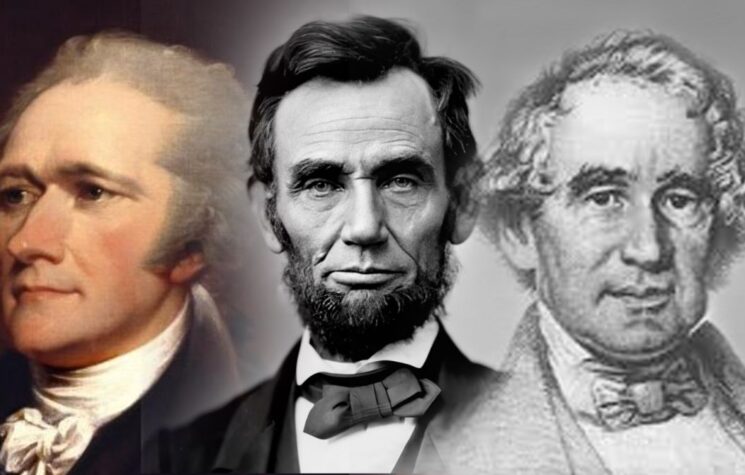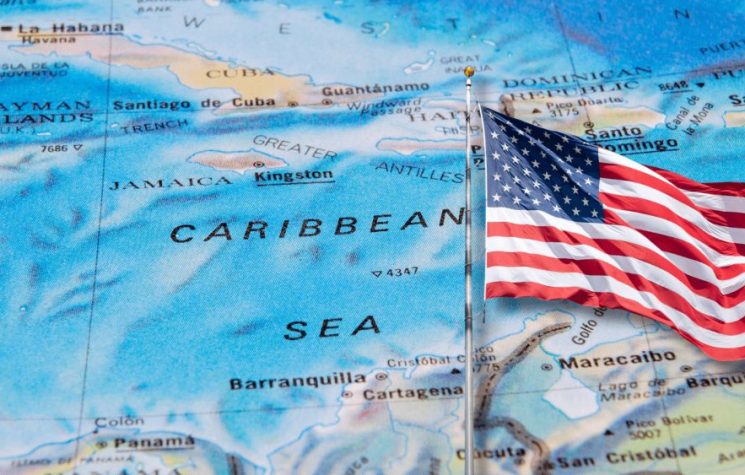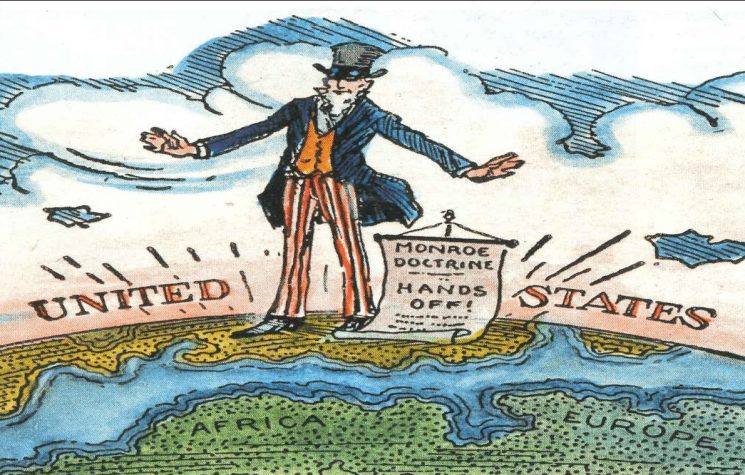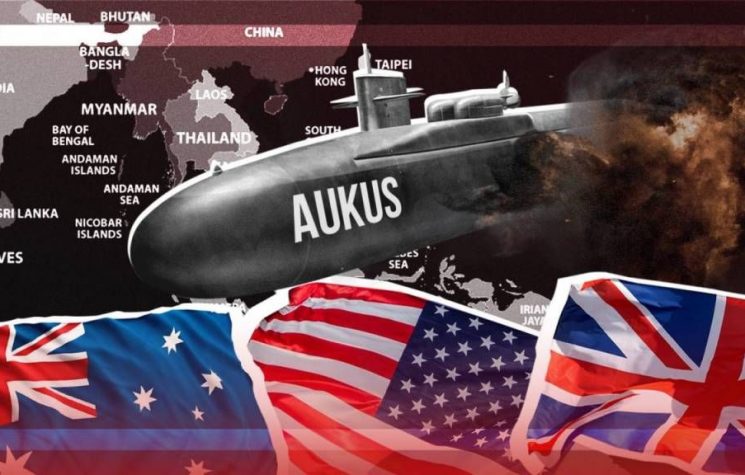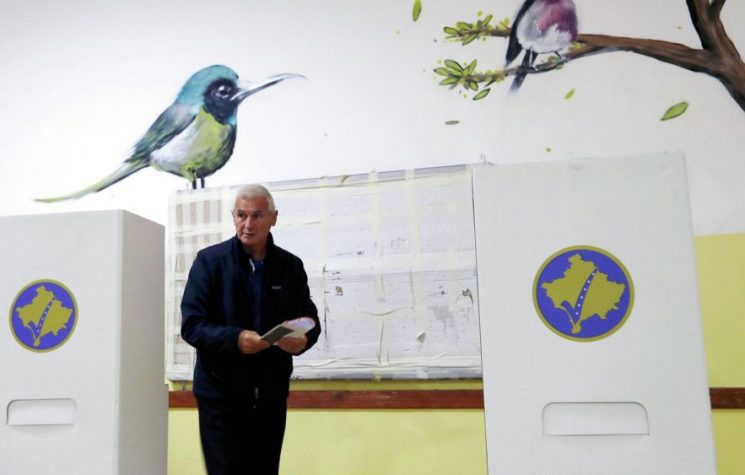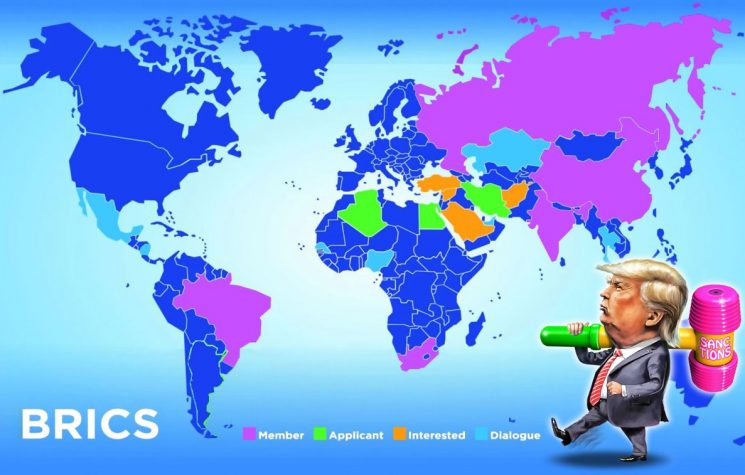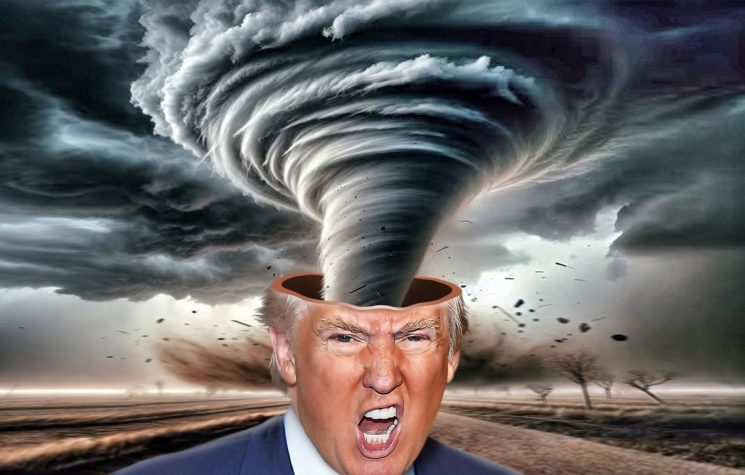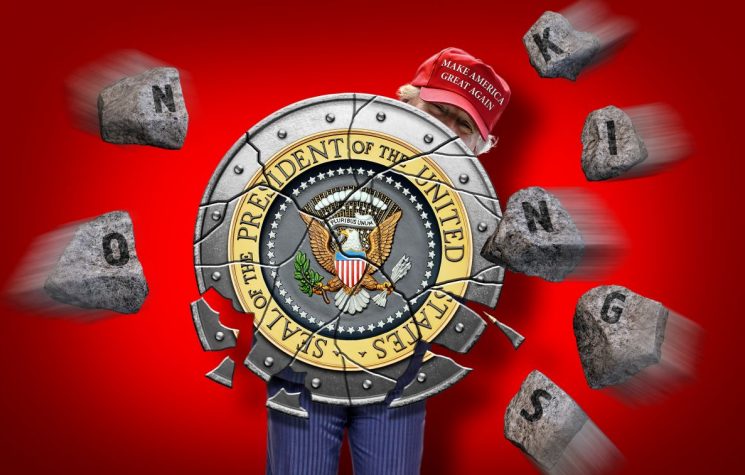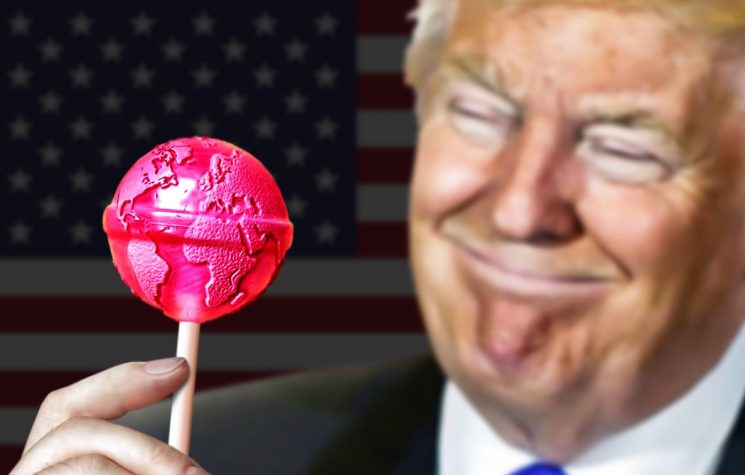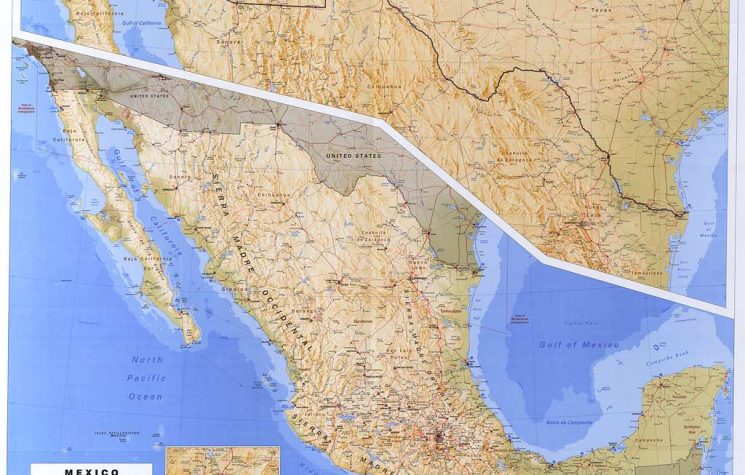Not that long ago the United States came close to total dissolution.
The financial system was bankrupt, speculation had run amok, and all infrastructure had fallen into disarray over the course of 30 years of unbroken free trade. To make matters worse, the nation was on the verge of a civil war and international financiers in London and Wall Street gloated over the immanent destruction of the first nation on earth to be established not upon hereditary institutions, but rather on the consent of the governed and mandated to serve the general welfare.
Although one might think that I am referring now to today’s America, I am in fact referring to the United States of 1860.
The Trifold Deep State
In my past two articles in this series, I discussed how a new system of political economy was established by Benjamin Franklin and his disciples in the wake of the war of independence driven by protectionism, national banking and internal improvements.
I also demonstrated that the rise of the thing known as today’s “deep state” can also be understood as a three-headed beast which arose in its earliest incarnation under the leadership of arch traitor Aaron Burr who established Wall Street, killed Alexander Hamilton and devoted his life to the cause of dissolving the union. After having been caught in the act of sabotage, Burr escaped arrest in 1807 by running off to England where he live in Jeremy Bentham’s mansion for 5 years, only to return to oversee a new plot to break up the union that eventually boiled over in 1860.
The three prongs of the operation that Burr led on behalf of British intelligence and which remains active to this very day, can loosely be described as follows:
- The Anglo-Canadian establishment that arose in the wake of the “United Empire Loyalists” who left the rebelling colonies in 1776 to found English speaking Canada and who were soon labelled as the “Family Compact” by republican revolutionary William Lyon Mackenzie and which ultimately managed the eventual creation of the Rhodes Trust under George Parkin and his heirs.
- The Eastern Establishment families sometimes known as the Essex Junto who took control of Hamilton’s Federalist Party. These were Empire Loyalists who remained within the USA under the illusion of loyalty to the constitution, but always adherent to a British Imperial world order and devoted to eventually undermining it from within. These were the circles that brought the USA into Britain’s Opium trade against China as junior partners in crime and who promoted the dissolution of the union as early as 1800 under the leadership of Aaron Burr.
- The “Virginia Junto”, slave owning aristocracy which also worked with Aaron Burr in his 1807 secessionist plot and whose alliance with the British Empire was instrumental in its rise to power from 1828-1860. This was the structure that soon returned to power, after the civil war, under the guiding hand of such Mazzini-connected “Young Americans” as KKK founder Albert Pike and the Southern establishment that later executed nationalist presidents in 1880, 1901 and in 1963.
Some Uncomfortable Questions
The story has been told of Lincoln’s murder in tens of thousands of books and yet more often than not the narrative of a “single lone gunman” is imposed onto the story by researchers who are either too lazy or too corrupt to look for the evidence of a larger plot.
How many of those popular narratives infused into the western zeitgeist over the decades even acknowledge the simple fact that John Wilkes Boothe was carrying a $500 bank draft signed by Ontario Bank of Montreal President Henry Starnes (later to become Montreal Mayor) when he was shot dead at Garrett Farm on April 26, 1865?
How many people have been exposed to the vast Southern Confederacy secret service operations active throughout the civil war in Montreal, Toronto and Halifax which was under the firm control of Confederate Secretary of State Judah Benjamin and his handlers in British intelligence?
How many people know that Boothe spent at least 5 weeks in the fall of 1864 in Montreal associating closely with the highest echelons of British and Southern intelligence including Starnes, and confederate spy leaders Jacob Thompson and George Sanders?
Demonstrating his total ignorance of the process that controlled him, Booth wrote to a friend on October 28, 1864: “I have been in Montreal for the last 3 or 4 weeks and no one (not even myself) knew when I would return”.
On The Trail of the Assassins
After Lincoln was murdered, a manhunt to track down the intelligence networks behind the assassination was underway that eventually led to the hanging of four low level co-conspirators who history has shown were just as much patsies as John Wilkes Boothe.
Days later, President Johnson issued a proclamation saying: “It appears from evidence in the Bureau of Military Justice that the … murder of … Abraham Lincoln … [was] incited, concerted, and procured by and between Jefferson Davis, late of Richmond, Va., and Jacob Thompson, Clement C. Clay, [Nathaniel] Beverly Tucker, George N. Sanders, William C. Cleary, and other rebels and traitors against the government of the United States harbored in Canada.”
Two days before Booth was shot, Secretary of War Edwin Stanton wrote: “This Department has information that the President’s murder was organized in Canada and approved at Richmond.”
Knowledge of Canada’s confederate operations was well known to the federal authorities in those days even though the majority among leading historians today are totally ignorant of this fact.
George Sanders remains one of the most interesting figures among Booth’s handlers in Canada. As a former Ambassador to England under the presidency of Franklin Pierce (1853-1857), Sanders was a close friend of international anarchist Giuseppe Mazzini – the founder of the Young Europe movement. Sanders who wrote “Mazzini and Young Europe” in 1852, had the honor of being a leading member of the southern branch of the Young America Movement (while Ralph Waldo Emerson was a self-proclaimed leader of the northern branch of Young America). Jacob Thompson, who was named in the Johnson dispatch above, was a former Secretary of the Interior under President Pierce, handler of Booth and acted as the top controller of the Confederacy secret service in Montreal.
As the book Montreal City of Secrets (2017), author Barry Sheehy proves that not only was Canada the core of Confederate Secret Services, but also coordinated a multi pronged war from the emerging “northern confederacy” onto Lincoln’s defense of the union alongside Wall Street bankers while the president was fighting militarily to stop the southern secession. Sheehy writes: “By 1863, the Confederate Secret Service was well entrenched in Canada. Funding came from Richmond via couriers and was supplemented by profits from blockade running.”
The Many Shapes of War from the North
Although not having devolved to direct military engagement, the Anglo-Canadian war on the Union involved several components:
Financial warfare: The major Canadian banks dominant in the 19th century were used not only by the confederacy to pay British operations in the construction of war ships, but also to receive much needed infusions of cash from British Financiers throughout the war. A financial war on Lincoln’s greenback was waged under the control of Montreal based confederate bankers John Porterfield and George Payne and also JP Morgan to “short” the greenback.
By 1864, the subversive traitor Salmon Chase had managed to tie the greenback to a (London controlled) gold standard thus making its value hinge upon gold speculation. During a vital moment of the war, these financiers coordinated a mass “sell off” of gold to London driving up the price of gold and collapsing the value of the U.S. dollar crippling Lincoln’s ability to fund the war effort.
Direct Military intervention Thwarted: As early as 1861, the Trent Crisis nearly induced a hot war with Britain when a union ship intervened onto a British ship in international waters and arrested two high level confederate agents en route to London. Knowing that a two-fold war at this early stage was unwinnable, Lincoln pushed back against hot heads within his own cabinet who argued for a second front saying “one war at a time”. Despite this near miss, London wasted no time deploying over 10 000 soldiers to Canada for the duration of the war ready to strike down upon the Union at a moment’s notice and kept at bay in large measure due to the bold intervention of the Russian fleet to both Atlantic and Pacific coasts of the USA. This was a clear message to both England and to Napoleon III’s France (who were stationed across the Mexican border) to stay out of America’s war.
Despite Russia’s intervention, Britain continued to build warships for the Confederacy which devastated the Union navy during the war and which England had to pay $15.5 million to the USA in 1872 under the Alabama Claims.
Terrorism: It is less well known today than it was during the 19th century that confederate terror operations onto the north occurred throughout the civil war with raids on Union POW camps, efforts to burn popular New York hotels, blowing up ships on the Mississippi, and the infamous St Albans raid of October 1964 on Vermont and attacks on Buffalo, Chicago, Sandusky, Ohio, Detroit, and Pennsylvania. While the St Albans raiders were momentarily arrested in Montreal, they were soon released under the logic that they represented a “sovereign state” at conflict with another “sovereign state” with no connection with Canada (perhaps a lesson can be learned here for Meng Wanzhou’s lawyers?).
Assassination: I already mentioned that a $550 note was found on Boothe’s body with the signature of Ontario Bank president Henry Starnes which the failed actor would have received during his October 1864 stay in Montreal. What I did not mention is that Booth stayed at the St Lawrence Hall Hotel which served as primary headquarters for the Confederacy from 1863-65. Describing the collusion of Northern Copperheads, anti-Lincoln republicans, and Wall Street agents, Sheehy writes: “All of these powerful northerners were at St. Lawrence Hall rubbing elbows with the Confederates who used the hotel as an unofficial Headquarters. This was the universe in which John Wilkes Booth circulated in Canada.”
In a 2014 expose, historian Anton Chaitkin, points out that the money used by Boothe came directly from a $31,507.97 transfer from London arranged by the head of European confederate secret service chief James D. Bulloch. It is no coincidence that Bulloch happens to also be the beloved uncle and mentor of the same Teddy Roosevelt who became the president over the dead body of Lincoln-follower William McKinley (assassinated in 1901).
In his expose, Chaitkin wrote:
“James D. Bulloch was the maternal uncle, model and strategy-teacher to future U.S. President Theodore Roosevelt. He emerged from the shadows of the Civil War when his nephew Teddy helped him to organize his papers and to publish a sanitized version of events in his 1883 memoir, The Secret Service of the Confederate States in Europe. Under the protection of imperial oligarchs such as Lord Salisbury and other Cecil family members, working in tandem with Britain’s military occupation of its then-colony Canada, Bulloch arranged English construction and crewing for Confederate warships that notoriously preyed upon American commerce.”
The Truth is Buried Under the Sands of History
While four low level members of Booth’s cell were hanged on July 7, 1865 after a four month show trial (1), the actual orchestrators of Lincoln’s assassination were never brought to justice with nearly every leading member of the confederate leadership having escaped to England in the wake of Lincoln’s murder. Even John Surrat (who was among the eight who faced trial) avoided hanging when his case was dropped, and his $25 000 bail was mysteriously paid by an anonymous benefactor unknown to this day. After this, Surrat escaped to London where the U.S. Consuls demands for his arrest were ignored by British authorities.

Confederate spymaster Judah Benjamin escaped arrest and lived out his days as a Barrister in England, and Confederate President Jefferson Davies speaking to adoring fans in Quebec in June 1867 encouraged the people to reject the spread of republicanism and instead embrace the new British Confederation scheme that would soon be imposed weeks later. Davies spoke to the Canadian band performing Dixie at the Royal Theater: “I hope that you will hold fast to their British principles and that you may ever strive to cultivate close and affectionate connections with the mother country”.
With the loss of Lincoln, and the 1868 death of Thaddeus Stevens, Confederate General Albert Pike established restoration of the southern oligarchy and sabotage of Lincoln’s restoration with the rise of the KKK, and renewal of Southern Rite Freemasonry. Over the ensuing years, an all out assault was launched on Lincoln’s Greenbacks culminating in the Specie Resumption Act of 1875 tying the U.S. financial system to British “hard money” monetarism and paving the way for the later financial coup known as the Federal Reserve Act of 1913 (2).
While the Southern Confederacy plot ultimately failed, Britain’s “other confederacy operation launched in 1864 was successfully consolidated with the British North America Act of July 1, 1867. The hoped-for extension of trans continental rail lines through British Columbia and into Alaska and Russia were sabotaged as told in the Real Story Behind the Alaska Purchase of 1867.
Instead of witnessing a new world system of sovereign nation states under a multipolar order of collaboration driven by international infrastructure projects as Lincoln’s followers like William Seward, Ulysses Grant, William Gilpin and President McKinley envisioned, a new age of war and empire re-asserted itself throughout the 20th century.
It was this same trifold Deep State that contended with Franklin Roosevelt and his patriotic Vice President Henry Wallace for power during the course of WWII, and it was this same beast that ran the assassination of President Kennedy in 1963. As New Orleans District Attorney Jim Garrison demonstrated in his book On the Trail of the Assassins (1991), Kennedy’s murder was arranged by a complex assassination network that brought into play Southern secret intelligence assets in Louisiana, and Texas, Wall Street financiers, and a strange assassination bureau based in Montreal named Permindex under the leadership of Maj. Gen. Louis Mortimer Bloomfield. This was the same intelligence operation that grew out of MI6’s Camp X in Ottawa during WWII and changed its name but not its functions during the Cold War. This is the same British Imperial complex that has been attempting to undo the watershed moment of 1776 for over 240 years.
It is this same tumor in the heart of the USA that has invested everything in a gamble to put their senile tool Joe Biden into the seat of the Presidency and oust the first genuinely nationalist American president the world has seen in nearly 60 years.
The author can be reached at matt.ehret@tutamail.com










